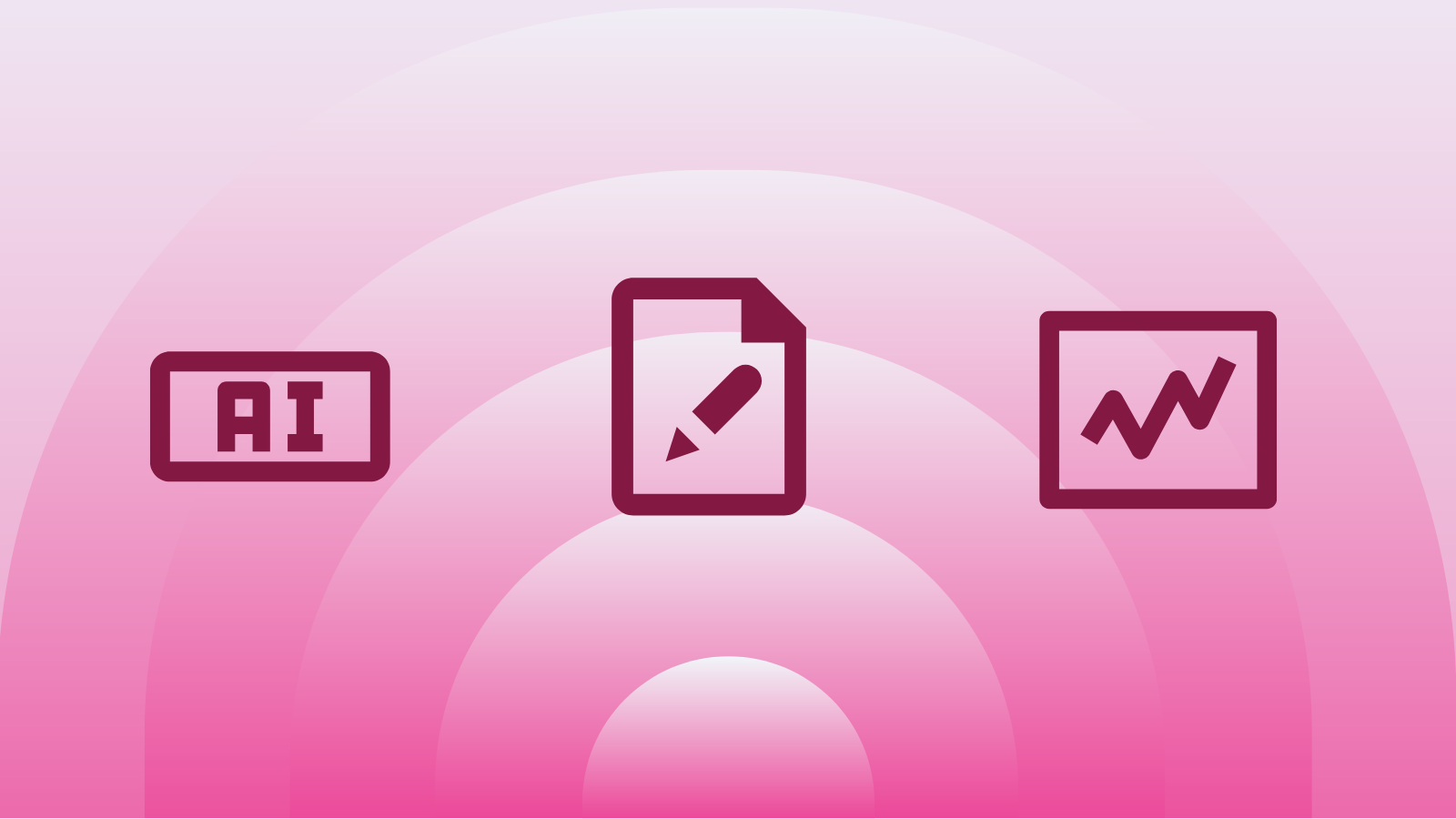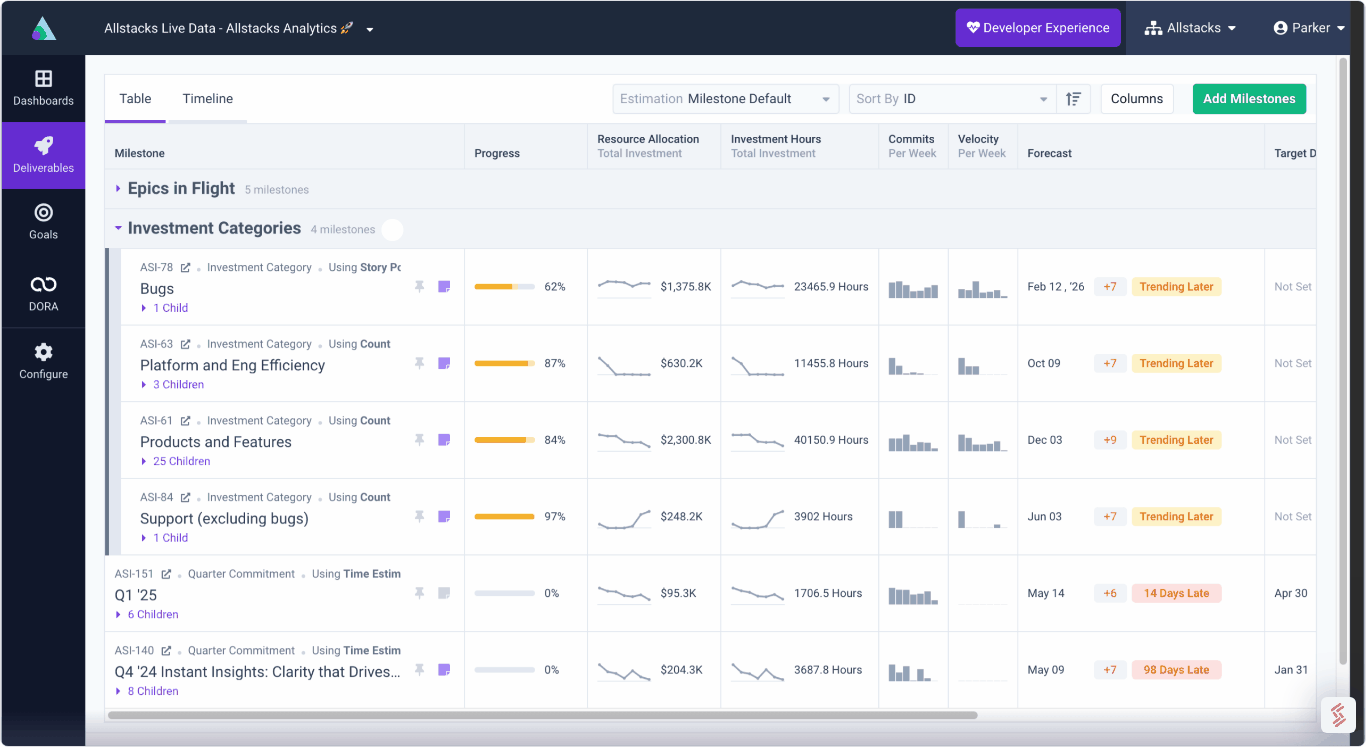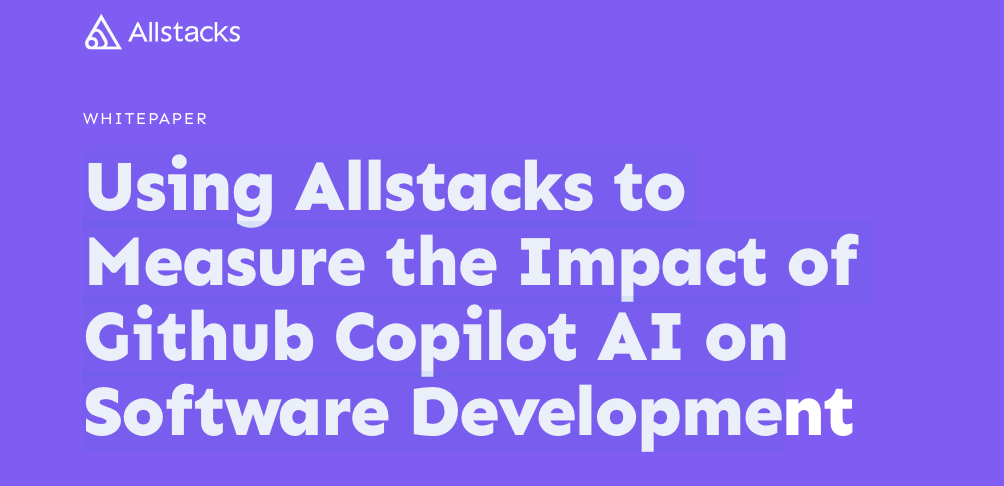.png)
Software Engineering Intelligence
-
Intelligence Engine
On-demand exhaustive AI-analysis
-
Engineering Investment
Complete visibility into time & dollars spent
-
360º Insights
Create meaningful reports and dashboards
-
Project Forecasting
Track and forecast all deliverables
DevEx
-
Developer Surveys
Create and share developer surveys
Software Capitalization
-
R&D Capitalization Reporting
Align and track development costs
Why Allstacks is Perfectly Built for AI
Let's talk about what makes Allstacks different when it comes to AI integration. While other companies are scrambling to bolt AI onto their existing platforms, we've built the perfect foundation for it.

We Solved the Data Mess First
Here's the thing about engineering data—it's everywhere and it's messy. You've got Jira tickets, GitHub commits, CircleCI builds, Azure DevOps work items, and dozens of other tools all speaking different languages. Most analytics platforms treat this like a data integration problem. We treat it like a translation problem.
When we ingest data from any tool, we don't just connect to it—we normalize it. Every piece of data becomes a "service entry" in our system, whether it's a Jira card or a Jenkins build. Think of it like having a universal translator that not only understands what each tool is saying, but also how they all relate to each other.
This matters for AI because instead of teaching an AI model to understand 20 different data formats, we've already translated everything into one consistent language.
The Secret Sauce: JSON Configuration Engine
Here's where it gets interesting. Our Metric Factory doesn't make you write SQL or force you into pre-built dashboards. Instead, it uses JSON configurations to define what you want to see.
A typical configuration might specify:
- What kind of chart you want
- Which data sources to pull from
- How to filter and group the data
- What time range to look at
- Which metrics to calculate
The system takes this JSON and generates the actual database queries behind the scenes. It sounds simple, but it's actually revolutionary for AI integration.
From "Show Me Velocity" to Actual Charts
Because we've vectorized our entire Metric Factory codebase, our AI doesn't just understand keywords—it understands the relationships between engineering concepts and how they translate to data queries.
Let's say a team lead asks: "I'd like to see the Tigers team's velocity over the last 90 days. Show me a line chart grouped by week, but exclude bugs—just stories and subtasks."
Here's what happens:
- The AI parses the natural language request
- It maps "Tigers team" to the correct team identifier in our system
- It understands "velocity" means story points completed over time
- It knows to exclude certain work item types (bugs)
- It generates the JSON configuration for a weekly line chart
- Our Metric Factory executes the query and returns the visualization
The user gets exactly what they asked for without writing a single line of code or clicking through multiple dropdown menus.
Why This Architecture Matters
Most companies are trying to add AI as a layer on top of their existing systems. We're able to integrate AI deeply into the core of how our platform works because:
- Unified data model: Everything speaks the same language
- Structured query interface: JSON configs are perfect for AI generation
- Rich context: Our AI understands engineering workflows, not just data
- Extensible foundation: New tools and metrics can be added without rebuilding
What Makes This Actually Work
Here's where things get really interesting. Most platforms trying to add AI are forcing the AI to write raw SQL queries. That's like asking someone to perform surgery with a chainsaw—technically possible, but messy and dangerous. You end up with syntax errors, slow queries, and potential security holes.
Our approach is different. The AI never touches the database directly. Instead, it just needs to understand our JSON configuration options—basically learning our "menu" of what's possible. It's like the difference between teaching someone to cook by giving them a recipe book versus throwing them into a professional kitchen and saying "figure it out."
This abstraction layer means our AI can be confident and fast because it's working within safe, tested boundaries.
Cross-Tool Magic
Remember how we normalized all that data? This is where it really pays off. Because everything speaks the same language in our system, the AI can easily connect dots across different tools without breaking a sweat.
Want to see how GitHub commit frequency correlates with Jira story completion and CircleCI build success rates? No problem. In traditional systems, that would require complex joins across multiple databases and tool-specific logic. For us, it's just another JSON configuration.
What's Next?
The best part about building this foundation correctly is that we're not locked into today's AI capabilities. The same JSON approach that powers natural language queries today can easily be extended to:
- Predictive analytics ("Based on current velocity, when will this epic be done?")
- Anomaly detection ("Your build times are 3x higher than usual this week")
- Automated insights ("The Tigers team consistently ships faster when they have smaller pull requests")
The Bottom Line
While everyone else is trying to retrofit AI onto platforms that weren't designed for it, we intentionally built the perfect AI platform by focusing on what engineering teams actually need: clean data and flexible queries.
We're not just ahead of the curve—we helped design it. And that means as AI gets smarter, we get more powerful, not more complicated.



.png)